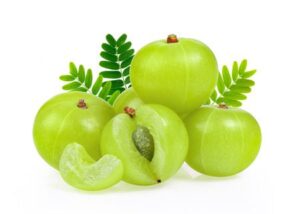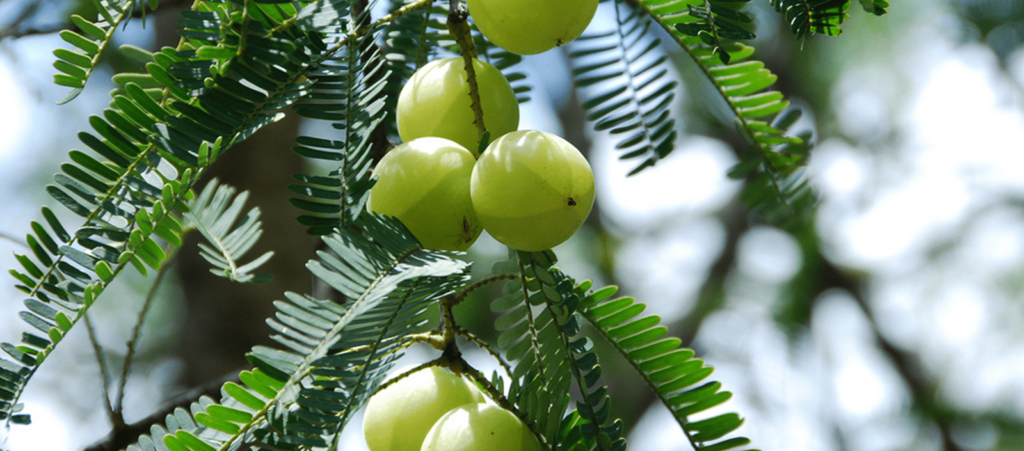Herb
Amalaki (Phyllanthus emblica) Herb Ayurvedic View
Amalaki (Phyllanthus emblica) is one of the essential herbs in Ayurveda that consists of fresh fruit pulp of Phyllanthus emblica. (Fam. Euphorbiaceae). Amla is a small or medium-sized tree with green globose fruits having a crooked trunk and spreading branches, found wild throughout tropical India, in mixed deciduous forests, ascending to 1300 m on hills, and cultivated in gardens and home yards. Amalaki (Phyllanthus emblica) is well-known for its immunity and anti-aging benefits and used as an excellent supplement during the fall and winter seasons for many years. Although it is rich source of Vitamin C, it boosts immunity naturally, supports digestion, metabolism, eliminates harmful toxins, and normalizes the liver organ’s function.
Amalaki (Phyllanthus emblica) or Gooseberry is considered as ‘’Rasayana’’. It has been identified to be a potent antioxidant, immunomodulatory, anti-stress, etc. Amalaki fruit is spherical pale yellow with six vertical furrows. The mature fruits are a hard and the average weight of the fruit is 60-70 g. The bark is gray and reddish wood. Amalaki (Phyllanthus emblica) leaves are feathery, linear-oblong and small in size. The taste of Amalaki (Phyllanthus emblica) is beneficial for all Doshas, which means everyone can take benefit from Amalaki, regardless of the individual mind-body constitution. Its sourness and sweetness create a strengthening and balancing effect on Vata dosha in the body, its sweetness and astringency balance Pitta dosha, and its astringent and pungent aspects help to dry out the dampness of Kapha dosha from the body.
Table of Contents
Scientific Classification of Amalaki (Phyllanthus emblica):
- Kingdom: Plantae
- Sub-Kingdom:Viridiplantae
- Infra Kingdom: Streptophyta
- Super Division: Embryophyta
- Class: Magnoliopsida
- Genus: Phyllanthus L. (Leaf Flower)
- Species: Phyllanthus Emblica (Emblic)
- Division: Tracheophyta/ Tracheophytes
- Sub Division: Spermatophytina/Spermatophytes (Seed Plants)
- Super Order: Rosanne
- Order: Malpighiales
Amalaki (Phyllanthus emblica) Synonyms:
- Sanskrit: Amalaka, Amrtaphala, Dhatriphala
- Assamese: Amlaku, Amlakhi, Amlakhu
- Bengali: Amla, Dhatri
- English: Emblic Myrobalan
- Gujrati: Ambala, Amala
- Hindi: Amla, Aonla
- Kannada: Nellikayi
- Kashmiri: Embali, Amli
- Malayalam: Nellikka
- Marathi: Anvala, Avalkathi
- Oriya: Anala, Ainla
- Punjabi: Aula, Amla
- Tamil: Nellikkai, Nelli
- Telugu: Usirika
- Urdu: Amla, Amlaj
Amalaki (Phyllanthus emblica) Description:
 a) Macroscopic: Amalaki (Phyllanthus emblica) Fruit is globose, 2.5-3.5 cm in diameter, fleshy, smooth with six prominent lines. When tender, the fruit is greenish, changing to light yellowish or pinkish color when mature, with a few dark specks. The taste is sour and astringent, followed by a delicately sweet flavor.
a) Macroscopic: Amalaki (Phyllanthus emblica) Fruit is globose, 2.5-3.5 cm in diameter, fleshy, smooth with six prominent lines. When tender, the fruit is greenish, changing to light yellowish or pinkish color when mature, with a few dark specks. The taste is sour and astringent, followed by a delicately sweet flavor.
b) Microscopic : The transverse section of the mature fruit shows an epicarp which consists of a single layer of the epidermis and 2-4 layers of hypodermis, epidermal cell. It is tabular in shape, covered externally with a thick cuticle, and appears in surface view as polygonal. The hypodermal cells are tangentially elongated, having thick-walled, smaller in dimension than epidermal cells.
The mesocarp forms bulk of fruit, consisting of thin-walled parenchymatous cells with intercellular spaces, peripheral 6-9 layers smaller, oval, or tangentially elongated. The rest of the cells are more prominent, isodiametric, and radially long. Several collateral fibrovascular bundles scattered throughout the mesocarp consisting of xylem and phloem. Xylem is composed of xylem fibers, tracheal elements, and fiber tracheids. Tracheal elements are having spiral thickenings and reticulate scalariform. In comparison, xylem fibers are elongated with a narrow lumen and pointed end.
Identity, Purity, and Strength of Amalaki (Phyllanthus emblica):
- Foreign matter Not more than 2 percent, Appendix 2.2.2.
- Total Ash Not more than 7 percent, Appendix 2.2.3.
- Acid-insoluble ash Not more than 2 percent, Appendix 2.2.4.
- Alcohol-soluble extractive Not less than 40 percent, Appendix 2.2.6.
- Water-soluble extractive Not less than 50 percent, Appendix 2.2.7.
- Moisture content Not less than 80 percent, Appendix 2.2.9.
Chemical Constituents of Amalaki (Phyllanthus emblica):
The main chemical constituents of Amalaki are Ascorbic acid, tannins, punigluconin, phyllanemblinin A, phyllanemblin , etc.
Ayurvedic Properties and Action of Amalaki (Phyllanthus emblica):
- Rasa: Amla, Kshaya, Madhura, Tikta, Katu
- Guna: Laghu, Ruksha
- Virya: Shita
- Vipaka: Madhura
- Karma: Vrishya, Rasayana, Chakshushaya, Tridosajit
Ayurvedic Formulation made by Amalaki (Phyllanthus emblica):
The most important Ayurvedic Formulation of Amalaki (Phyllanthus emblica) are Chyawanprash, Amalaki Rasayana, Dhatryarishta, Dhatriloha
Therapeutic Uses of Amalaki (Phyllanthus emblica):
Amalaki effectively works in Raktapitta, Amlapitta, Prameha, Daha, Sarvdoshaghana, Pramehaghan.
Dose of Amalaki (Phyllanthus emblica):
- 3-5gm of the drug
- 5-10 ml of fresh juice
Reference:
Ayurvedic Pharmacopeia of India.


